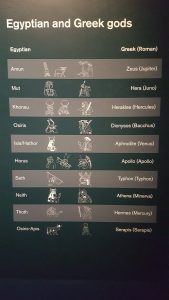I had the pleasure of going to the British Museum’s Sunken Cities exhibition the other evening. It focuses on two Egyptian cities -Thonis-Heracleion and Canopus – which thrived in the Delta area from the early years of the first millennium BC, through until the middle of the first millennium AD. Rising sea levels and subsidence of the land made them progressively less and less habitable, and they were abandoned by around 1000 AD. For many years they were lost, and textual references thought to be fictional, until they were rediscovered quite recently. The exhibition shows the current state of the ongoing underwater archaeological work to recover and restore the contents.
Let me first say that the range and scope of items on display is extraordinary. Whole sections of the cities sank in situ, so both everyday and ceremonial artefacts have been beautifully preserved. They have been shielded from breakage, theft, rebuilding, earthquake damage, and a whole range of other difficulties which face land-based finds. Some of the most striking exhibits are the statues – of deities, women, and men – and the curators have positioned these well so as to draw your eye from hall to hall.

Another major theme of the exhibition is to show what these lost cities show us of Egypt’s relationships with the wider Mediterranean world, especially Greece. The earliest and most successful Greek settlements were in this part of the Delta, and the cross-cultural interactions were particularly rich. Many of the items show how Egyptian and Greek tried to understand one another, and adapt their own creative styles as they learned from each other. The Greeks found some aspects of Egyptian religion quite incomprehensible, especially the blend of both human and animal traits in gods and goddesses. Nevertheless, they were prepared to adapt their practice to fit in with local customs, and interpreted their own pantheon in Egyptian terms.
Despite this, some Greek philosophers were disparaging of this habit of Egyptian religion as they wrote. “We eat the mouse, while they worship it” is a typical sentiment. This ultimately arose from a belief that humanity was the apex of creation – from that perspective it was absurd to contemplate animal traits as anything more than a convenient and temporary disguise. I came away wondering if part of our ongoing ecological crisis is rooted in this classical assumption of human superiority, and whether the world would be in a different state if European thinking had been shaped more by Egyptian than Greek dominance.
All in all, this exhibition is well worth seeing if you get the opportunity. Whether your interest is drawn by philosophical and religious questions, cross-cultural interactions, or just a fine array of cool artefacts, there’s something here for you. It continues until late November.
